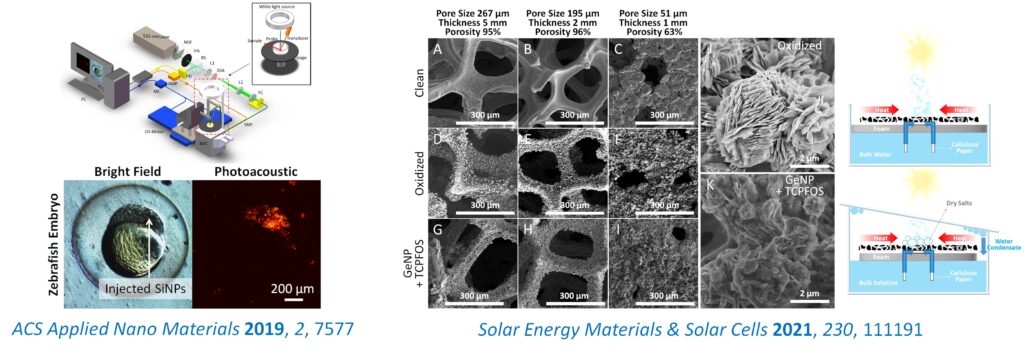In our research group, we focus on inorganic semiconductor nanomaterials, such as silicon quantum dots (SiQDs), which can be synthesized by top-down or bottom-up approaches. Based on their unique optical properties, we explore their niche applications in the energy and biomedical fields.
SiQD Luminescent Solar Concentration (Energy)
Due to the indirect bandgap nature of silicon, the SiQDs mainly absorb UV light, re-emitting red fluorescence. As a result, the overlap between the absorption and photoluminescence spectra is negligible, which is a highly desirable property for the luminescent solar concentrators (LSCs) to mitigate re-absorption. As propagating toward the LSC edges by total internal reflection for the photovoltaic conversion, the SiQD fluorescence photons are hardly re-absorbed, enabling both efficient and large-area SiQD-LSCs. Recently, in our research group the SiQD-LSCs have been applied for solar windows and enhancing perovskite solar cell performance.

SiQD Time-Gated Fluorescence Imaging & Photosensitization (Biomedical)
For the SiQDs, since the photoluminescence process involves the defect states resulting from surface oxidation, particularly Si-O-Si, the photoluminescence lifetime is relatively long, > 20 microseconds. In comparison, other direct bandgap semiconductor QDs (e.g. CdSe QDs), organic dyes and background autofluorescence, have photoluminescence lifetimes in nanoseconds. Therefore, by using the time-gating method with the SiQDs as the long-lived contrast agents, background-free, high-contrast and time-domain multiplexed immunofluorescence imaging can be achieved. On the other hand, owing to the long photoluminescence lifetime, the SiQDs can also function as photosensitizers, generating cytotoxic singlet oxygens for the photodynamic therapy.

Photothermal: Photoacoustic Imaging (Biomedical) & Solar Desalination (Energy)
In our research group, we also synthesize photothermal semiconductor nanomaterials, such as Si, Ge and CuS nanoparticles, which have extensive NIR-absorption ability, high molar extinction coefficients and exceptional biocompatibility. On the biomedical side, such nanoparticles, after being conjugated with biomolecules, can be used as contrast agents for the photoacoustic imaging. On the energy side, the nanoparticles deposited films can absorb nearly entire solar spectrum and convert into heat, which can be harvested for the solar steam generation.
